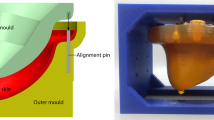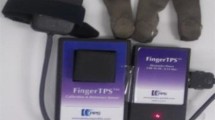Abstract
Finite element (FE) models are increasingly used to validate experimental data in breast cancer. This research constructed a biomechanical FE model for breast shaped phantoms used to develop and validate a mechanical vibration based screening system. Such models do not currently exist but would enhance development of this screening technology. Three phantoms were modelled: healthy, with 10 and 20 mm inclusions. The overall goal was to create models with enough accuracy to replace experimental phantoms in providing data to optimize diagnostic algorithms for digital image-based elasto-tomography (DIET) screening technologies. FE model results were validating against experimental DIET phantom data for over 4000 collected points on each model and phantom using cross-correlation coefficients between experimental simulated data and direct comparison. Results showed good to strong correlation ranging from 0.7 to 1.0 in all cases with over 90% having a value over 0.9. Magnitudes for each frame of the dynamic response also matched well, indicating that the material properties and geometry were accurate enough to provide this level of correlation. These results justify the use of FE model generated data for in silico diagnostic algorithm development testing. The overall modelling and validation approach is not overly complex, and thus generalizable to similar problems using mechanical properties of silicone phantoms, and might be extensible to human cases with further work.

Validate that dynamic displacements show that the model can be used in place of phantoms for rapid development of diagnostic algorithms that use surface motion to detect underlying mechanical properties.











Similar content being viewed by others
References
A. C. Society. Available: https://www.cancer.org/
Society AC (2017) Cancer facts & figures 2017. American Cancer Society, Atlanta
Coleman C (2017) Early detection and screening for breast cancer. Semin Oncol Nurs 33:141–155
Nelson HD, O’Meara ES, Kerlikowske K, Balch S, Miglioretti D (2016) Factors associated with rates of false-positive and false-negative results from digital mammography screening: an analysis of registry data. Ann Intern Med 164:226–235
Lee CI, Chen LE, Elmore JG (2017) Risk-based breast cancer screening. Med Clin 101(4):725–741
Edell S, Eisen M (1999) Current imaging modalities for the diagnosis of breast cancer. Del Med J 71:377–382
Hardy J, Powles T, Judson I, Heron C, Williams M, Cherryman G et al (1990) How many tests are required in the diagnosis of palpable breast abnormalities? Clin Oncol 2:148–152
Smith RA, Saslow D, Sawyer KA, Burke W, Costanza ME, Evans W et al (2003) American Cancer Society guidelines for breast cancer screening: update 2003. CA Cancer J Clin 53:141–169
Hina Muhammad I, Christopher GP, Matthew KS, Marcus H, Chase JG (2017) Attributes, performance, and gaps in current & emerging breast cancer screening technologies. Curr Med Imaging Rev 13:1–10
Peters A, Milsant A, Rouzé J, Ray L, Chase JG, Houten EEWV (2004) Digital image-based elasto-tomography: proof of concept studies for surface based mechanical property reconstruction. JSME Int J C Mech Syst, Mach Elem Manuf 47:1117–1123
Peters A, Chase JG, Van Houten EEW (2009) Estimating elasticity in heterogeneous phantoms using digital image elasto-tomography. Med Biol Eng Comput 47:67–76
Kashif AS, Lotz TF, Heeren AMW, Chase JG (2013) Separate modal analysis for tumor detection with a digital image elasto tomography (DIET) breast cancer screening system. Med Phys 40:113503
Zhou C, Chase JG, Ismail H, Pretty C, Rodgers GW, Signal MK et al (2017) Nominal stiffness identification for tumor detection of women breast in a digital image elasto tomography (DIET) system. IFAC-PapersOnLine 50:2031–2036
Zhou C, Chase JG, Ismail H, Signal MK, Haggers M, Rodgers GW et al (2018) Silicone phantom validation of breast cancer tumor detection using nominal stiffness identification in digital imaging elasto-tomography (DIET). Biomed Signal Proc Control 39:435–447
Zhou C, Chase JG, Ismail H, Rodgers GW, Pretty C, Signal M et al (2017) A surface vibration-based method for tumor detection of women breast in a DIET system. Procedia Eng 199:310–315
Hann CE, Chase JG, Chen X, Berg C, Brown RG, Elliot RB (2009) Strobe imaging system for digital image-based elasto-tomography breast cancer screening. IEEE Trans Ind Electron 56:3195–3202
Peters A, Wortmann S, Elliott R, Staiger M, Chase JG, Houten EV (2005) Digital image-based elasto-tomography: first experiments in surface based mechanical property estimation of gelatine phantoms. JSME Int J S C Mech Syst Mach Elem Manuf 48:562–569
Van Houten EEW, Peters A, Chase JG (2011) Phantom elasticity reconstruction with digital image elasto-tomography. J Mech Behav Biomed Mater 4:1741–1754
Brown RG, Hann CE, Chase JG, Ray L (2007) Discrete color-based Euclidean-invariant signatures for feature tracking in a DIET breast cancer screening system. In: Medical imaging 2007: physiology, function, and structure from medical images, vol. 6511. International Society for Optics and Photonics, Christchurch, New Zealand
Brown RG, Hann CE, Chase JG (2008) Vision-based 3D surface motion capture for the DIET breast cancer screening system, in Mechatronics and machine vision in practice, 2008. M2VIP 2008. 15th International Conference on, pp. 628–633
Brown RG, Chase JG, Hann CE (2012) A pointwise smooth surface stereo reconstruction algorithm without correspondences. Image Vis Comput 30:619–629
Arleo EK, Hendrick RE, Helvie MA, Sickles EA (2017) Comparison of recommendations for screening mammography using CISNET models. Cancer 123:3673–3680
Kashif AS, Lotz TF, McGarry MD, Pattison AJ, Chase JG (2013) Silicone breast phantoms for elastographic imaging evaluation. Med Phys 40:063503
Hina MI, Christopher GP, Matthew KS, Marcus H, Cong Z, Chase JG (2017) Mechanical behaviour of tissue mimicking breast phantom materials. Biomed Phys Eng Expr 3:045010
Azar FS, Metaxas DN, Schnall MD (2001) A deformable finite element model of the breast for predicting mechanical deformations under external perturbations. Acad Radiol 8:965–975
Liu Y-L, Liu P-Y, Huang M-L, Hsu J-T, Han R-P, Wu J (2017) Simulation of breast compression in mammography using finite element analysis: a preliminary study. Radiat Phys Chem 140:295–299
Ruiter N, Müller T, Stotzka R, Gemmeke H, Reichenbach J, Kaiser W (2002) Automatic image matching for breast cancer diagnostics by a 3d deformation model of the mamma. Biomed Tech/Biomed Eng 47:644–647
Lee AWC, Rajagopal V, Babarenda Gamage TP, Doyle AJ, Nielsen PMF, Nash MP (2013) Breast lesion co-localisation between X-ray and MR images using finite element modelling. Med Image Anal 17:1256–1264
Schnabel JA, Tanner C, Castellano-Smith AD, Degenhard A, Leach MO, Hose DR, Hill DLG, Hawkes DJ (2003) Validation of nonrigid image registration using finite-element methods: application to breast MR images. IEEE Trans Med Imaging 22:238–247
Washington CW, Miga MI (2004) Modality independent elastography (MIE): a new approach to elasticity imaging. IEEE Trans Med Imaging 23:1117–1128
Rajagopal V, Chung J-H, Bullivant D, Nielsen PMF, Nash MP (2007) Determining the finite elasticity reference state from a loaded configuration. Int J Numer Methods Eng 72:1434–1451
Botterill T, Lotz T, Kashif A, Chase JG (2014) Reconstructing 3-D skin surface motion for the DIET breast cancer screening system. IEEE Trans Med Imaging 33:1109–1118
Krouskop TA, Wheeler TM, Kallel F, Garra BS, Hall T (1998) Elastic moduli of breast and prostate tissues under compression. Ultrason Imaging 20:260–274
Fung Y-C (2013) Biomechanics: mechanical properties of living tissues. Springer Science & Business Media, Berlin
Hibbitt, Karlsson, and Sorensen (2001) ABAQUS/standard user’s manual, vol 1. Hibbitt, Karlsson & Sorensen, Providence
Abaqus V (2014) 6.14 Documentation. Dassault Systemes Simulia Corporation, Johnston
Rajagopal V, Nielsen P Nash M (2003) A 3D finite element model of the breast to study breast cancer, in World congress on medical physics and biomedical engineering
Mooney M (1940) A theory of large elastic deformation. J Appl Phys 11:582–592
Wellman P, Howe RD, Dalton E, Kern KA (1999) Breast tissue stiffness in compression is correlated to histological diagnosis, Harvard BioRobotics Laboratory Technical Report
Gennisson JL, Deffieux T, Fink M, Tanter M (2013) Ultrasound elastography: principles and techniques. Diagn Interv Imaging 94:487–495
Goddi A, Bonardi M, Alessi S (2012) Breast elastography: a literature review. J Ultrasound 15:192–198
Gheonea IA, Stoica Z, Bondari S (2011) Differential diagnosis of breast lesions using ultrasound elastography. Indian J Radiol Imaging 21:301
Author information
Authors and Affiliations
Corresponding author
Rights and permissions
About this article
Cite this article
Ismail, H.M., Pretty, C.G., Signal, M.K. et al. Finite element modelling and validation for breast cancer detection using digital image elasto-tomography. Med Biol Eng Comput 56, 1715–1729 (2018). https://doi.org/10.1007/s11517-018-1804-5
Received:
Accepted:
Published:
Issue Date:
DOI: https://doi.org/10.1007/s11517-018-1804-5




